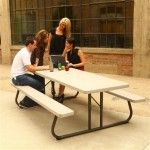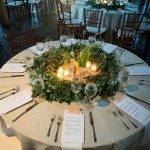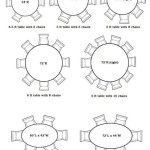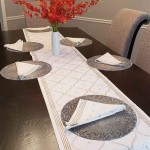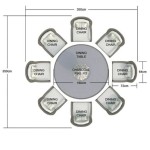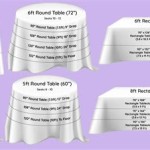How To Set A Table With Round Placemats
Setting a table properly elevates a dining experience, transforming a simple meal into a more sophisticated and enjoyable occasion. While the basic principles of table setting remain consistent, incorporating round placemats introduces a specific visual element that requires careful consideration. A well-set table, even with a casual meal, communicates respect for the guests and enhances the overall atmosphere. This article provides a comprehensive guide to setting a table using round placemats, covering various levels of formality and practical tips for achieving a balanced and aesthetically pleasing arrangement.
Round placemats offer a softer, more modern alternative to traditional rectangular placemats. Their circular shape contrasts with the straight lines often found in dinnerware and furniture, creating visual interest. However, the round shape also requires a different approach to placement and balancing the elements on the table. Understanding the specific considerations involved with using round placemats ensures a harmonious and functional table setting.
Key Point 1: Understanding the Fundamentals of Table Setting
Before diving into the specifics of using round placemats, it's essential to revisit the foundational principles of table setting. These principles apply regardless of the shape of the placemat or the level of formality, ensuring a consistent structure and functionality. Correct placement of utensils, plates, and glassware is crucial for both aesthetic appeal and practical convenience for diners.
The basic elements of table setting include the dinner plate, which serves as the foundation of the arrangement, along with the necessary utensils, glassware, and napkins. The placement of these items adheres to a specific protocol. Forks are placed to the left of the plate, knives to the right, with the blade facing the plate, and spoons to the right of the knives. The napkin is typically placed to the left of the forks or on the plate, depending on the level of formality. Water glasses are positioned above the knife, and wine glasses are arranged to the right of the water glass, depending on the wines being served.
Understanding the order of use for utensils is also vital. The outermost utensils are used first, working inward toward the plate with each course. For example, if a salad fork is provided, it is placed to the left of the dinner fork and used before the main course fork. This logical arrangement helps guide diners through the meal and prevents confusion. Bread plates, when used, are positioned to the upper left of the dinner plate, with a butter knife placed horizontally across the plate or resting on the side.
The specific items included in a table setting will vary depending on the menu and the occasion. A casual meal might only require a dinner plate, fork, knife, spoon, napkin, and water glass. A more formal setting could include multiple forks for different courses, soup spoons, salad plates, bread plates, and various wine glasses. Adapting the table setting to the specific needs of the meal ensures that each course is properly served and that diners have the appropriate utensils at their disposal.
The arrangement of all these elements should be symmetrical and balanced, creating a visually pleasing and functional setting. While there is room for creativity and personal style, adhering to these basic principles ensures a professional and polished look. Paying attention to the details, such as ensuring that all utensils are clean and polished, and that linens are crisp and wrinkle-free, further enhances the overall dining experience.
Key Point 2: Adapting Table Setting Techniques for Round Placemats
While the fundamental principles of table setting remain constant, adapting them to accommodate round placemats requires careful consideration. The circular shape of the placemat introduces unique challenges and opportunities in terms of placement, balance, and overall aesthetic. Understanding how to work with this specific shape is crucial for achieving a visually appealing and functional table setting.
One of the first considerations is the size of the round placemat relative to the dinnerware. The placemat should be large enough to comfortably accommodate the dinner plate without appearing crowded. Ideally, there should be a visible border of the placemat surrounding the plate, creating a visual frame. Conversely, the placemat should not be so large that it overwhelms the table setting or encroaches on the space of other diners.
Centering the dinner plate on the round placemat is essential for creating a balanced and harmonious look. This ensures that the plate is the focal point of the setting and that the surrounding utensils are positioned symmetrically around it. Using a visual guide or measuring the center point of the placemat can help ensure accurate placement. The round shape of the placemat emphasizes the need for precise centering to avoid an unbalanced appearance.
The placement of utensils around the round placemat also requires attention to detail. While the traditional rule of placing forks to the left and knives and spoons to the right still applies, the curved edge of the placemat can influence the visual alignment. It is important to ensure that the utensils are parallel to each other and that they are evenly spaced around the plate. Using the edge of the placemat as a guide can help maintain consistent spacing and alignment.
Napkins can be placed in a variety of ways when using round placemats. They can be folded and placed to the left of the forks, on the plate, or even in a decorative napkin ring. The choice of placement depends on the level of formality and the overall aesthetic. For a more casual setting, the napkin can be folded simply and placed to the side. For a more formal setting, the napkin can be elaborately folded and placed on the plate or in a napkin ring, adding a touch of elegance to the table setting.
The arrangement of glassware also needs to be considered in relation to the round placemat. Water glasses are typically placed above the knife, and wine glasses are arranged to the right. The curved edge of the placemat can create a visual contrast with the straight lines of the glassware, adding visual interest. It is important to ensure that the glassware is placed in a way that is both functional and aesthetically pleasing. Using different heights and shapes of glassware can further enhance the visual appeal of the table setting.
Consider the overall shape of the table as well. Round placemats tend to work best on round or square tables, echoing the circular shapes and creating a cohesive look. On rectangular tables, they can provide a visual break from the straight lines, but attention should be paid to the overall balance of the table. Consider using a runner to tie the place settings together or to add a contrasting element.
Key Point 3: Levels of Formality and Additional Considerations
The level of formality dictates the specific items included in the table setting and the manner in which they are arranged. Using round placemats can be appropriate for various levels of formality, from casual family meals to more elaborate dinner parties. Understanding the distinctions between different levels of formality allows for a tailored and appropriate table setting.
For a casual table setting using round placemats, the focus is on simplicity and functionality. A basic setting might include a dinner plate, fork, knife, spoon, napkin, and water glass. The napkin can be folded simply and placed to the left of the forks or on the plate. The arrangement should be relaxed and informal, reflecting the nature of the meal. Decorative elements can be kept to a minimum, focusing instead on creating a comfortable and welcoming atmosphere.
A semi-formal table setting using round placemats introduces additional elements and a slightly more refined arrangement. This might include a salad plate, soup bowl, and additional glassware for wine or other beverages. The napkin can be folded more elaborately and placed on the plate or in a napkin ring. Utensils for each course are arranged in the order of use, working from the outside in. The overall look should be elegant but not overly formal, suitable for a dinner party or special occasion.
A formal table setting using round placemats represents the highest level of sophistication and attention to detail. This setting might include multiple forks for different courses, a bread plate with a butter knife, several wine glasses, and a dessert spoon and fork. The napkin is typically elaborately folded and placed on the plate or in a decorative napkin ring. The arrangement follows strict rules of etiquette, with each item placed precisely and symmetrically. Decorative elements, such as floral arrangements and candles, can be used to enhance the ambiance and create a memorable dining experience.
Beyond the basic elements of table setting, there are several additional considerations that can further enhance the overall look and feel. Color coordination is an important factor, ensuring that the placemats, dinnerware, linens, and other accessories complement each other. Choosing a cohesive color scheme creates a visually pleasing and harmonious setting. Consider using contrasting colors to add visual interest or opting for a monochromatic scheme for a more sophisticated look.
Texture also plays a significant role in table setting. Different textures can add depth and dimension to the overall design. Using placemats with a textured surface, such as woven fibers or embossed patterns, can create a tactile and visually interesting element. Combining different textures, such as smooth china with rough linen, can further enhance the sensory experience of the meal. Consider the interplay of textures when selecting placemats, dinnerware, and linens.
Centerpieces can add a focal point to the table and enhance the overall atmosphere. For a round table with round placemats, a circular centerpiece can echo the shapes and create a cohesive look. Alternatively, a linear centerpiece can provide a contrasting element and add visual interest. The size and height of the centerpiece should be appropriate for the table, ensuring that it does not obstruct the view of diners or interfere with conversation. Consider using floral arrangements, candles, or other decorative objects to create a visually appealing centerpiece.
Lighting is another crucial element that can significantly impact the ambiance of the dining experience. Soft, warm lighting creates a more inviting and relaxed atmosphere, while bright, harsh lighting can feel sterile and uninviting. Consider using dimmer switches to adjust the lighting as needed. Candles can also be used to create a warm and romantic ambiance. Ensure that the lighting is appropriate for the occasion and the overall style of the table setting.
Finally, paying attention to the small details can make a big difference in the overall impression of the table setting. Ensuring that all items are clean and polished, that linens are crisp and wrinkle-free, and that utensils are properly aligned demonstrates attention to detail and respect for the guests. Taking the time to carefully arrange each element ensures that the table setting is both functional and aesthetically pleasing, enhancing the dining experience for everyone involved.

How To Decorate A Round Table

American Placemats How To Use Them Borgo Delle Tovaglie

How To Decorate A Round Table

Placemats For Round Table Visualhunt

How To Decorate A Round Table

American Placemats How To Use Them Borgo Delle Tovaglie

How To Set A Dining Table Based On The Shape

How To Set A Table With Runner And Placemats Cv Linens

Place Setting Inspiration

4 Expert Tips To Choose Placemats Visualhunt
Related Posts

